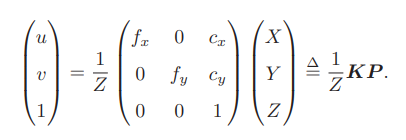ceres---相机重投影误差
相机重投影误差
相机归一化公式:

相机归一化与外参变换公式:

相机畸变:


代码:
// Templated pinhole camera model for used with Ceres. The camera is // parameterized using 9 parameters: 3 for rotation, 3 for translation, 1 for // focal length and 2 for radial distortion. The principal point is not modeled // (i.e. it is assumed be located at the image center). struct SnavelyReprojectionError { SnavelyReprojectionError(double observed_x, double observed_y) : observed_x(observed_x), observed_y(observed_y) {} template <typename T> bool operator()(const T* const camera, const T* const point, T* residuals) const { // camera[0,1,2] are the angle-axis rotation. T p[3]; AngleAxisRotatePoint(camera, point, p); // camera[3,4,5] are the translation. p[0] += camera[3]; p[1] += camera[4]; p[2] += camera[5]; // Compute the center of distortion. The sign change comes from // the camera model that Noah Snavely's Bundler assumes, whereby // the camera coordinate system has a negative z axis. const T xp = - p[0] / p[2]; const T yp = - p[1] / p[2]; // Apply second and fourth order radial distortion. const T& l1 = camera[7]; const T& l2 = camera[8]; const T r2 = xp*xp + yp*yp; const T distortion = 1.0 + r2 * (l1 + l2 * r2); // Compute final projected point position. const T& focal = camera[6]; const T predicted_x = focal * distortion * xp; const T predicted_y = focal * distortion * yp; // The error is the difference between the predicted and observed position. residuals[0] = predicted_x - observed_x; residuals[1] = predicted_y - observed_y; return true; } // Factory to hide the construction of the CostFunction object from // the client code. static ceres::CostFunction* Create(const double observed_x, const double observed_y) { return (new ceres::AutoDiffCostFunction<SnavelyReprojectionError, 2, 9, 3>( new SnavelyReprojectionError(observed_x, observed_y))); } double observed_x; double observed_y; }; // Templated pinhole camera model for used with Ceres. The camera is // parameterized using 10 parameters. 4 for rotation, 3 for // translation, 1 for focal length and 2 for radial distortion. The // principal point is not modeled (i.e. it is assumed be located at // the image center). struct SnavelyReprojectionErrorWithQuaternions { // (u, v): the position of the observation with respect to the image // center point. SnavelyReprojectionErrorWithQuaternions(double observed_x, double observed_y) : observed_x(observed_x), observed_y(observed_y) {} template <typename T> bool operator()(const T* const camera, const T* const point, T* residuals) const { // camera[0,1,2,3] is are the rotation of the camera as a quaternion. // // We use QuaternionRotatePoint as it does not assume that the // quaternion is normalized, since one of the ways to run the // bundle adjuster is to let Ceres optimize all 4 quaternion // parameters without a local parameterization. T p[3]; QuaternionRotatePoint(camera, point, p); p[0] += camera[4]; p[1] += camera[5]; p[2] += camera[6]; // Compute the center of distortion. The sign change comes from // the camera model that Noah Snavely's Bundler assumes, whereby // the camera coordinate system has a negative z axis. const T xp = - p[0] / p[2]; // x/z const T yp = - p[1] / p[2]; // y/z // Apply second and fourth order radial distortion. const T& l1 = camera[8]; const T& l2 = camera[9]; const T r2 = xp*xp + yp*yp; const T distortion = 1.0 + r2 * (l1 + l2 * r2); // Compute final projected point position. const T& focal = camera[7]; const T predicted_x = focal * distortion * xp; const T predicted_y = focal * distortion * yp; // The error is the difference between the predicted and observed position. residuals[0] = predicted_x - observed_x; residuals[1] = predicted_y - observed_y; return true; } // Factory to hide the construction of the CostFunction object from // the client code. static ceres::CostFunction* Create(const double observed_x, const double observed_y) { return (new ceres::AutoDiffCostFunction< SnavelyReprojectionErrorWithQuaternions, 2, 10, 3>( new SnavelyReprojectionErrorWithQuaternions(observed_x, observed_y))); } double observed_x; double observed_y; };



